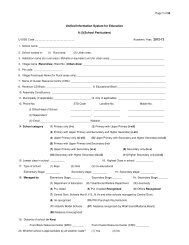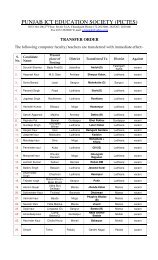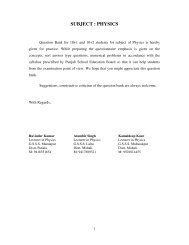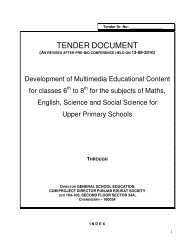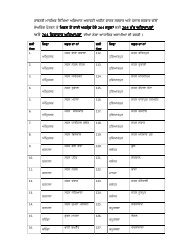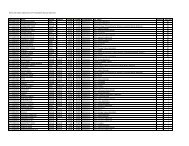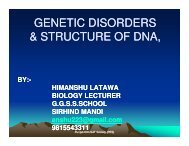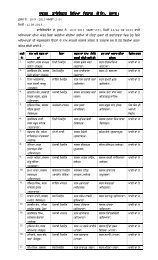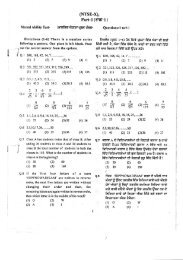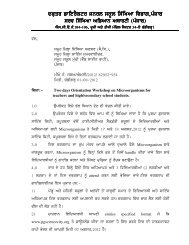Sex Linked Inheritance, Chromosome Mapping ... - SSA Punjab
Sex Linked Inheritance, Chromosome Mapping ... - SSA Punjab
Sex Linked Inheritance, Chromosome Mapping ... - SSA Punjab
You also want an ePaper? Increase the reach of your titles
YUMPU automatically turns print PDFs into web optimized ePapers that Google loves.
<strong>Sex</strong> <strong>Linked</strong> <strong>Inheritance</strong>,<br />
<strong>Chromosome</strong> <strong>Mapping</strong><br />
&<br />
Mutations<br />
By – Surinder Kaur<br />
DIET Ropar<br />
Surinder-1998@ yahoo.in<br />
Mob No 9988530775<br />
<strong>Punjab</strong> EDUSAT Society{PES}
S<br />
E<br />
X<br />
Discovery<br />
T.H. Morgan<br />
L<br />
I<br />
N<br />
K<br />
E<br />
D<br />
I<br />
N<br />
H<br />
E<br />
R<br />
I<br />
T<br />
A<br />
N<br />
C<br />
E<br />
Genes<br />
Control<br />
On <strong>Sex</strong>-<strong>Chromosome</strong>s<br />
Called <strong>Sex</strong> <strong>Linked</strong> Genes<br />
<strong>Sex</strong>-<strong>Linked</strong><br />
Characters<br />
Criss-Cross Type Mother Son<br />
Father<br />
Examples<br />
to<br />
<strong>Punjab</strong> EDUSAT Society{PES}<br />
daughters<br />
Most traits are recessive<br />
Hemophilia<br />
to<br />
Colour Blindness<br />
Grand<br />
Daughter<br />
Grandson
<strong>Sex</strong>-linked Traits<br />
• Traits (genes) located on the sex<br />
chromosomes<br />
• <strong>Sex</strong> chromosomes are X and Y<br />
• XX genotype for females<br />
• XY genotype for males<br />
• Many sex-linked traits carried on X<br />
chromosome<br />
<strong>Punjab</strong> EDUSAT Society{PES}<br />
copyright cmassengale<br />
3
<strong>Sex</strong>-linked Traits<br />
Example: Eye color in fruit flies<br />
<strong>Sex</strong> <strong>Chromosome</strong>s<br />
fruit fly<br />
eye color<br />
XX chromosome - female<br />
<strong>Punjab</strong> EDUSAT Society{PES}<br />
Xy chromosome - male<br />
copyright cmassengale<br />
4
Hemophilia<br />
Parents Normal X Hemophilic<br />
Woman Man<br />
Genotypes XX X h Y<br />
Gametes<br />
X X X h Y<br />
X h<br />
Y<br />
Progeny X XX h XY<br />
<strong>Punjab</strong> EDUSAT XSociety{PES}<br />
XX h XY
Parents Hemophilic X Carrier<br />
Man<br />
Woman<br />
Genotypes X h Y XX h<br />
Gametes<br />
X h Y X X h<br />
Progeny<br />
X<br />
<strong>Punjab</strong> EDUSAT Society{PES}<br />
X h<br />
X h X h X X h X h Lethal<br />
Y XY X h Y
<strong>Punjab</strong> EDUSAT Society{PES}
<strong>Punjab</strong> EDUSAT Society{PES}
Cross-over frequencies can be converted<br />
into map units.<br />
– gene A and gene B cross over 6.0<br />
percent of the time<br />
– gene B and gene C<br />
cross over 12.5 percent<br />
of the time<br />
– gene A and gene C cross over 18.5 percent of the<br />
time<br />
<strong>Punjab</strong> EDUSAT Society{PES}
Linkage maps estimate distances<br />
between genes.<br />
• The closer together two genes are, the<br />
more likely they will be inherited together.<br />
• Cross-over frequencies are related to<br />
distances between genes.<br />
• Linkage maps show the relative locations<br />
of genes.<br />
<strong>Punjab</strong> EDUSAT Society{PES}
MUTATIONS<br />
Mutations can be defined as<br />
sudden, stable, discontinuous and<br />
inheritable variations which appear<br />
due to permanent change in the<br />
genotype of an organism .<br />
They are responsible for the origin<br />
of new traits and therefore<br />
mutations are the source of all<br />
variations .<br />
<strong>Punjab</strong> EDUSAT Society{PES}
Somatic vs Germ Mutations<br />
Some people may have mutations in<br />
their skin cells or hair. Such mutations<br />
are termed Somatic. Germ mutations<br />
occur only in the sex cells.<br />
These mutations are more threatening<br />
because they can be passed to offspring<br />
(forever).<br />
<strong>Punjab</strong> EDUSAT Society{PES}
Types of mutations<br />
Chromosomal:<br />
affecting whole<br />
or a part of a<br />
chromosome<br />
<strong>Punjab</strong> EDUSAT Society{PES}<br />
Gene: changes<br />
to the bases in<br />
the DNA of one<br />
gene
Chromosomal Mutations<br />
1.Morphological modification of chromosomes<br />
• Deletion<br />
• Inversion<br />
Intra-chromosomal<br />
modification<br />
• Translocation<br />
• Duplication<br />
Inter-chromosomal<br />
modification<br />
2. Numerical changes in chromosome<br />
• Aneuploidy<br />
• Euploidy<br />
<strong>Punjab</strong> EDUSAT Society{PES}
Deletion<br />
1. In a deletion, part of a chromosome is missing<br />
a. Deletions start with chromosomal breaks<br />
induced by:<br />
i. Heat or radiation (especially ionizing).<br />
ii. Viruses.<br />
iii. Chemicals.<br />
v. Errors in recombination.<br />
b.Deletions do not revert, because the DNA is missing.<br />
2.The effect of a deletion depends on what was<br />
deleted.<br />
<strong>Punjab</strong> EDUSAT Society{PES}
Deletion in <strong>Chromosome</strong><br />
<strong>Punjab</strong> EDUSAT Society{PES}
Inversion<br />
1. Inversion results when a chromosome segment<br />
excises and reintegrates oriented 180 0 from the<br />
original orientation. There are two types:<br />
a. Pericentric inversions include the centromere.<br />
b. Paracentric inversions do not include the<br />
centromere.<br />
2. Inversions generally do not result in lost DNA,<br />
but phenotypes can arise if the breakpoints are<br />
in genes or regulatory regions.<br />
<strong>Punjab</strong> EDUSAT Society{PES}
INVERSIONS<br />
<strong>Punjab</strong> EDUSAT Society{PES}
Duplication<br />
Duplications result from doubling of<br />
chromosomal segments, and occur in a range<br />
of sizes and locations.<br />
a. Tandem duplications are adjacent to each other.<br />
b. Reverse tandem duplications result in genes<br />
arranged in the opposite order of the original.<br />
c. Tandem duplication at the end of a chromosome is<br />
a terminal tandem duplication.<br />
<strong>Punjab</strong> EDUSAT Society{PES}
Duplication<br />
(a chromosome segment repeated)<br />
<strong>Punjab</strong> EDUSAT Society{PES}
Forms of chromosome duplications are tandem,<br />
reverse tandem and terminal tandem duplications<br />
<strong>Punjab</strong> EDUSAT Society{PES}
Variations in <strong>Chromosome</strong> Number<br />
1. An organism or cell is euploid when it has one<br />
complete set of chromosomes, or exact multiples of<br />
complete sets. Eukaryotes that are normally haploid<br />
or diploid are euploid, as are organisms with variable<br />
numbers of chromosome sets.<br />
2. Aneuploidy results from variations in the number of<br />
individual chromosomes (not sets), so that the<br />
chromosome number is not an exact multiple of the<br />
haploid set of chromosomes.<br />
<strong>Punjab</strong> EDUSAT Society{PES}
Numerical changes in chromosomes<br />
Euploidy<br />
Aneuploidy<br />
monoploidy<br />
(n)<br />
polyploidy<br />
(3n,4n,5n,6n etc)<br />
hypoploidy<br />
hyperploidy<br />
diploidy<br />
(2n)<br />
monosomy<br />
(2n-1)<br />
nullisomy<br />
(2n-2)<br />
<strong>Punjab</strong> EDUSAT Society{PES}<br />
trisomy<br />
(2n+1<br />
tetrasomy<br />
(2n+2)
Normal theoretical set of metaphase<br />
chromosomes in a diploid (2N) organism top<br />
and example of aneuploidy (bottom)<br />
<strong>Punjab</strong> EDUSAT Society{PES}
Changes in Complete Sets of<br />
<strong>Chromosome</strong>s<br />
Monoploidy and polyploidy involve<br />
complete sets of chromosomes, and so both<br />
are cases of euploidy.<br />
<strong>Punjab</strong> EDUSAT Society{PES}
Euploidy is lethal in most animal species,<br />
but often tolerated in plants, where it has<br />
played a role in speciation and<br />
diversification.<br />
Monoploidy and polyploidy can result<br />
when either round of meiotic division<br />
lacks cytokinesis, or when meiotic<br />
nondisjunction occurs for all<br />
chromosomes.<br />
<strong>Punjab</strong> EDUSAT Society{PES}
Variations in number of complete<br />
<strong>Chromosome</strong> sets<br />
<strong>Punjab</strong> EDUSAT Society{PES}
Plant polyploidy occurs in two types:<br />
i. Autopolyploidy results when all sets of<br />
chromosomes are from the same species,<br />
usually due to meiotic error. Fusion of a<br />
diploid gamete with a haploid one<br />
produces a triploid organism. Examples<br />
include:<br />
“Seedless” fruits like bananas, grapes<br />
and watermelons.<br />
<strong>Punjab</strong> EDUSAT Society{PES}
ii. Allopolyploidy results when the<br />
chromosomes are from two different<br />
organisms, typically from the fusion of<br />
haploid gametes followed by chromosome<br />
doubling. For example:<br />
Fusion of haploid gametes from plant 1 and<br />
plant 2 produces an N 1 + N 2 hybrid plant.<br />
<strong>Punjab</strong> EDUSAT Society{PES}



